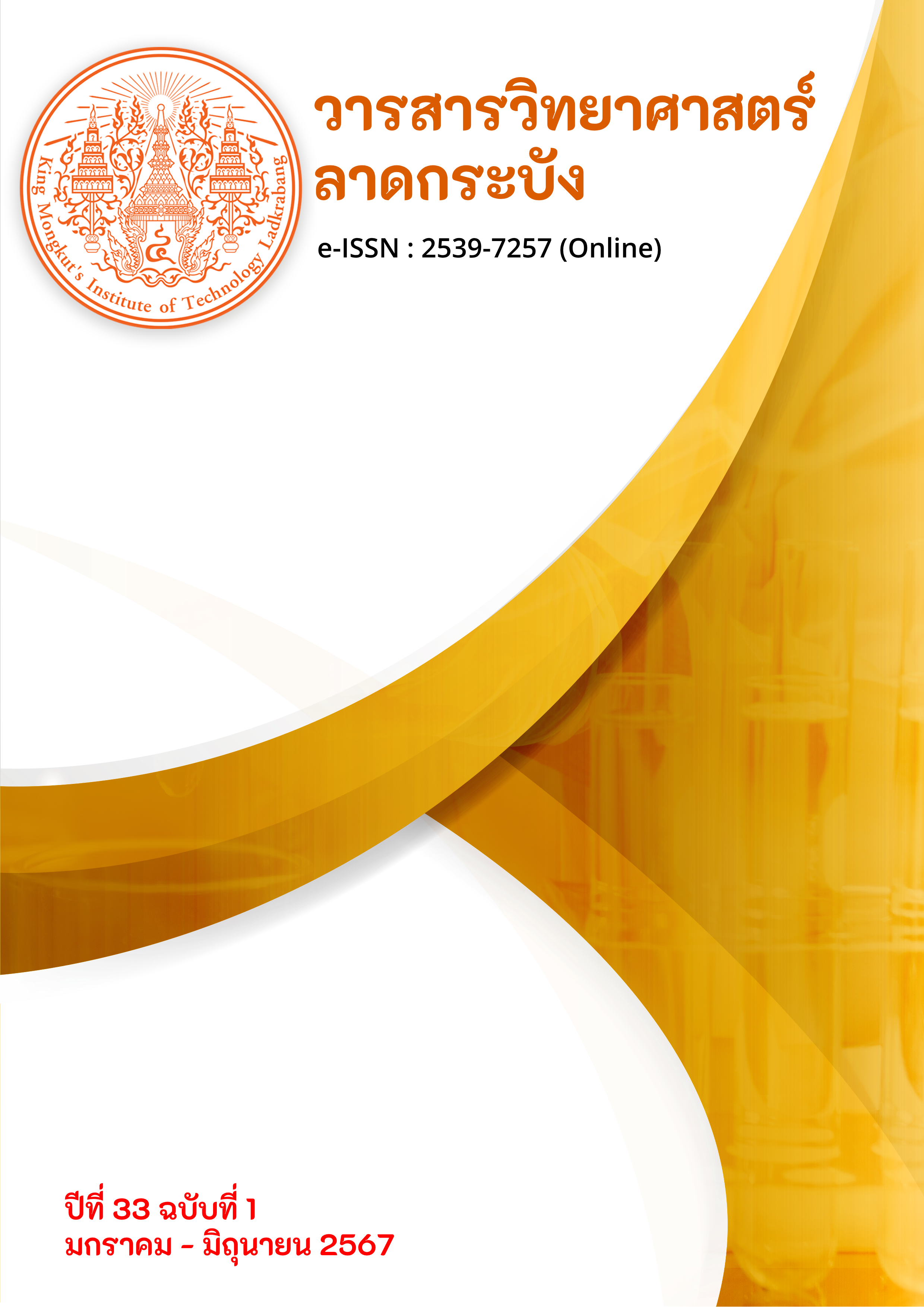การศึกษาการระบาดของโรค Covid-19 ระลอกที่ 5 ในประเทศไทย โดยใช้ตัวแบบทางคณิตศาสตร์
Main Article Content
บทคัดย่อ
โรคโควิด-19 เป็นโรคติดต่อจากคนสู่คนซึ่งเกิดจากละอองฝอยขนาดเล็กจากการไอหรือจาม โดย ในปัจจุบันประเทศไทยได้มีการแพร่ระบาดเชื้อโควิด-19 สายพันธุ์โอมิครอน ในระลอกที่ 5 ซึ่งพบผู้ติดเชื้อเป็นจำนวนมาก เมื่อเทียบกับระลอกก่อนหน้านี้ ทำให้ผู้วิจัยสนใจศึกษาการแพร่ระบาด และมาตรการในการป้องกันโรคจากการฉีดวัคซีนทั้ง 3 เข็ม จึงได้พัฒนาและสร้างตัวแบบทางคณิตศาสตร์ ซึ่งประกอบด้วย 8 กลุ่มประชากร ได้แก่ กลุ่มประชากรที่เสี่ยงติดเชื้อ (S) กลุ่มประชากรที่เสี่ยงติดเชื้อที่ได้รับวัคซีน (Sv) กลุ่มประชากรที่ติดเชื้อ (อาการไม่รุนแรง: I) กลุ่มประชากรที่เข้ารับการรักษาในโรงพยาบาล (อาการรุนแรง: H1) กลุ่มประชากรที่เข้ารับการรักษาในห้อง ICU (อาการวิกฤต: C) กลุ่มประชากรที่พักฟื้นจากการรักษาที่ห้อง ICU ในโรงพยาบาล (H2) กลุ่มประชากรที่หายจากการติดเชื้อ (R) และกลุ่มประชากรที่เสียชีวิตจากการติดเชื้อ (D) เพื่ออธิบายการแพร่ระบาดโควิด-19 และศึกษาผลกระทบของการฉีดวัคซีนในการควบคุมการแพร่ระบาดโรคโควิด-19 ซึ่งได้มีการศึกษากลุ่มประชากรติดเชื้อเพื่อหาค่าระดับการติดเชื้อพื้นฐาน (R0) จากนั้นทำการวิเคราะห์เชิงคณิตศาสตร์และวิเคราะห์เชิงตัวเลข พบว่าเสถียรภาพเฉพาะที่ของจุดสมดุลภายใต้สภาวะแพร่ระบาดจะมีเสถียรภาพเชิงเส้นกํากับเฉพาะที่ ถ้า R0>1 และจะไม่มีเสถียรภาพเชิงเส้นกํากับเฉพาะที่ ถ้า R0<1 นอกจากนี้ผู้วิจัยยังวิเคราะห์ความอ่อนไหวตัวแบบทางคณิตศาสตร์ของค่าระดับการติดเชื้อพื้นฐาน จากการวิเคราะห์พบว่าพารามิเตอร์ที่มีผลกระทบต่อค่าระดับการติดเชื้อพื้นฐาน คือ τi,mi,γ และพารามิเตอร์ที่มีผลกระทบต่อกลุ่มประชากรที่ติดเชื้อภายใต้สภาวะการแพร่ระบาดมากที่สุด คือ β,η,sv^i ตามลำดับ นอกจากนี้ยังพบอีกว่าการฉีดวัคซีนเข็มที่ 1 และ 2 มีประสิทธิภาพในการควบคุมการแพร่กระจายโรคโควิด-19 ที่ไม่แตกต่างกันอย่างมีนัยสำคัญ ซึ่งต่างจากการฉีดวัคซีนครบทั้ง 3 เข็ม พบว่ามีประสิทธิภาพในการควบคุมการแพร่กระจายโรค ได้ดีกว่าการฉีดวัคซีนเพียงแค่สองเข็ม
Article Details

อนุญาตภายใต้เงื่อนไข Creative Commons Attribution-NonCommercial-NoDerivatives 4.0 International License.
เอกสารอ้างอิง
Huang, C. et al. 2020. Clinical features of patients infected with 2019 novel coronavirus in Wuhan, China. The Lancet, 395(10223), 497-506, https://doi.org/10.1016/S0140-6736(20)30183-5.
Worid Health Organization. 2021. Listings of WHO’s response to COVID-19. Available at: https://www.who.int/news/item/29-06-2020-covidtimeline. Retrieved 16 May 2023.
BARRETO, C. and MEJIA, M. 2021. Peru’s intensive care units at capacity as virus cases surge. Available at: https://apnews.com/article/lima-coronavirus-pandemic-peru-847fb33c1f5c49ca70b66227f0435e2e. Retrieved 16 May 2023.
National Statistical Office. 2021. Demography Population and Housing. Available at: http://statbbi.nso.go.th/staticreport/page/sector/th/01.aspx. Retrieved 19 May 2023.
Department of Disease Control. 2022. DDC COVID-19 Interactive Dashboard. Available at: https://ddc.moph.go.th/covid19-dashboard/?dashboard=main. Retrieved 12 May 2023.
Rajatanavin, N., Tuangratananon, T., Suphanchaimat, R. and Tangcharoensathien, V. 2021. Responding to the COVID-19 second wave in Thailand by diversifying and adapting lessons from the first wave. BMJ global health, 6(7), https://doi.org/10.1136/bmjgh-2021-006178.
World Health Organization Country Office for Thailand. 2022. COVID-19 Situation in Thailand. Available at: https://t.ly/bm8Ac. Retrieved 17 May 2023.
Keeling, M.J., and Rohani, P. 2008. Modeling Infectious Diseases in Humans and Animals, Princeton University Press, https://doi.org/10.2307/j.ctvcm4gk0.
Chen, Z. et al. 2022. SEIR model with unreported infected population and dynamic parameters for the spread of COVID-19. Mathematics and computers in simulation, 198, 31-46, https://doi.org/10.1016/j.matcom.2022.02.025.
Teklu, S. W. 2022. Mathematical analysis of the transmission dynamics of COVID-19 infection in the presence of intervention strategies. Journal of Biological Dynamics, 16(1), 640-664, https://doi.org/10.1080/17513758.2022.2111469.
Ayoola, T. A., Kolawole, M. K. and Popoola, A. O. 2022. Mathematical model of COVID-19 transmission dynamics with double dose vaccination. Tanzania Journal of Science, 48(2), 499-512, https://doi.org/10.4314/tjs.v48i2.23.
Marinov, T. T. and Marinova, R. S. 2022. Inverse problem for adaptive SIR model: Application to COVID-19 in Latin America. Infectious Disease Modelling, 7(1), 134-148, https://doi.org/10.1016/j.idm.2021.12.001.
Youssef, H., Alghamdi, N., Ezzat, M. A., El-Bary, A. A. and Shawky, A. M. 2021. Study on the SEIQR model and applying the epidemiological rates of COVID-19 epidemic spread in Saudi Arabia. Infectious Disease Modelling, 6, 678-692, https://doi.org/10.1016/j.idm.2021.04.005.
Alqahtani, R. T. 2021. Mathematical model of SIR epidemic system (COVID-19) with fractional derivative: stability and numerical analysis. Advances in Difference Equations, 2021(1), 1-16, https://doi.org/10.1186/s13662-020-03192-w.
Ahmad, N. 2020. COVID-19 modeling in Saudi Arabia using the modified Susceptible-Exposed-Infectious-Recovered (SEIR) model. Cureus, 12(9), https://doi.org/10.7759/cureus.10452.
Theparod, T., Kreabkhontho, P. and Teparos, W. 2023. Booster Dose Vaccination and Dynamics of COVID-19 Pandemic in the Fifth Wave: An Efficient and Simple Mathematical Model for Disease Progression. Vaccines, 11(3), 589, https://doi.org/10.3390/vaccines11030589.
Ledford, H. 2020. COVID-19 reinfection: three questions scientists are asking. Nature, 585(7824), 168-169, https://doi.org/10.1038/d41586-020-02506-y.
The Bureau of Registration Administration. 2021. Number of births and deaths in Thailand 2021. Available at: https://t.ly/BS9lw. Retrieved 22 May 2023.
Van den Driessche, P. and Watmough, J. 2002. Reproduction numbers and sub-threshold endemic equilibria for compartmental models of disease transmission. Mathematical biosciences, 180(1-2), 29-48, https://doi.org/10.1016/S0025-5564(02)00108-6.
PHAT, B. and Ngoc, V. 2001. Introduction to mathematical control theory. Hanoi National University Publisher, Hanoi.
DeJesus, E.X. and C. Kaufman. 1987. Routh-Hurwitz criterion in the examination of eigenvalues of a system of nonlinear ordinary differential equations. Physical Review A, 35(12), 5288, https://doi.org/10.1103/PhysRevA.35.5288.
Department of Disease Control. 2021. Guidelines for people who need COVID-19 Epidemic Situation 2021 in Thailand. Available at: https://ddc.moph.go.th/vaccine-covid19/getFiles/11/1628849610213.pdf. Retrieved 19 May 2023.
Chitnis, N., Hyman, J.M., and Cushing, J.M. 2008. Determining important parameters in the spread of malaria through the sensitivity analysis of a mathematical model. Bulletin of mathematical biology, 70, 1272-1296, https://doi.org/10.1007/s11538-008-9299-0.
Coutsias, E.A., Seok, C. and Dill, K.A. 2004. Using quaternions to calculate RMSD. Journal of Computational Chemistry, 25(15), 1849-1857, https://doi.org/10.1002/jcc.20110.

